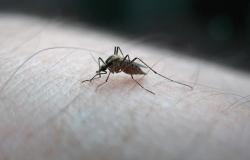The alert has been sounded: a very first case of avian influenza A H5N1 was recorded in Canada, in British Columbia, on Saturday. Here is why the authorities are not laughing with this “notifiable” virus, according to federal public health.
What is H5N1 flu?
Influenza A H5N1 is a virus transmitted by birds which mainly affects the respiratory tract, but which can also contaminate the gastrointestinal system or the central nervous system.
Although it is a subtype of avian flu, that is to say it mainly infects birds, cases of contamination have been observed in other animals or even in humans, for whom the disease can progress. towards a more serious infection and even become fatal.
H5N1 influenza is relatively rare in humans, but is closely monitored as a “notifiable” disease to the World Health Organization (WHO) under the International Health Regulations, may – we read on the website of the Public Health Agency of Canada.
Getty Images via AFP
As of November 14, 46 people have been infected with H5N1 in the United States, according to the Centers for Disease Control and Prevention, which reports 25 infections caused by cows, 20 by birds and one from a source unknown.
How is the H5N1 virus transmitted?
There are three ways to become infected with H5N1 avian flu: by contact with a contaminated animal, by contact with a contaminated environment or by consuming raw food contaminated by the virus.
For the moment, no lasting human-to-human infections have been observed for H5N1 influenza and cases of human-to-human transmission are rare, according to public health.
Contact with an animal
In contaminated animals, the virus is found in secretions – that is to say mucus and saliva –, blood and excrement, and is transmitted to humans by inhalation or by contact with mucous membranes, such as eyes, nose and mouth, according to Public Health Agency of Canada.
Photo d’archives
H5N1 can also survive on poultry feathers for several weeks or even months at cooler temperatures, while cases of human infections have been reported after the plucking of contaminated dead swans.
Thus, the virus circulates in particular through close contact with a contaminated domestic or wild bird, although it cannot be ruled out that an infected mammal could also transmit H5N1 to humans, even if this would be very rare at present.
Environmental exposure
In the same vein, the virus can be transmitted by simple contact with a contaminated environment, for example, a poultry farm or a live bird market.
In theory, humans could catch H5N1 avian flu through contact with a water source contaminated with the virus, such as bathing in a domestic pond, but this risk has only been suggested in a small number of studies. .
By food
Generally speaking, certain raw animal foods can be contaminated with viruses or bacteria and cause infection in humans when consumed.
Although thorough cooking appears to be sufficient to kill the H5N1 virus, there is currently insufficient research to assess its level of contamination through food, which remains low for the moment.
The risk, however, is higher for those who hunt, handle or cook birds and other wild animals and their eggs.
Photo Adobe Stock
What are the symptoms?
In most cases, the incubation period of the virus lasts between 1 and 5 days, sometimes up to 9 days, before the first symptoms appear, according to the federal agency.
These include cough, fever, shortness of breath, diarrhea in severe cases, headache, muscle pain, sore throat, runny nose, bleeding from mucous membranes, fatigue, jaundice or even conjunctivitis, that is to say inflammation of the eye.
In the worst cases, the infection can progress to multiorgan failure – which affects several organs –, pulmonary hemorrhage, pneumothorax – a condition which affects the lungs – or even pancytopenia, which affects blood cells.
To date, the mortality rate for H5N1 is set at 52%, but this could be much lower since mild infections are not necessarily recorded.
Are there treatments for the H5N1 virus?
Confirmed cases of H5N1 are currently treated with specific antivirals for influenza, which should ideally be started within 48 hours of the onset of illness to reduce the intensity of the illness and its mortality.
In addition to antivirals, some patients may require respiratory support depending on the progression of the disease.
Kishyru – stock.adobe.com
Is there a vaccine against H5N1?
There is no avian flu vaccine available to the public in Canada at this time, and seasonal flu vaccines do not provide protection against H5N1, according to the government website.
Prevention: some actions to adopt
To avoid being contaminated by H5N1, here are some actions to adopt on a daily basis:
- Make sure to properly cook all products of animal origin, including meat, but also eggs, to kill possible viruses, parasites and bacteria;
- Consume pasteurized milk and dairy products;
- Adopt safety rules for handling or preparing food, including hand washing and separating raw foods from other food products to avoid cross-contamination;
- For hunters or those who collect wild bird eggs, take extra precautions to avoid contamination;
- For breeders or those in close contact with wild birds, exercise high vigilance and take additional precautions to reduce risk.






